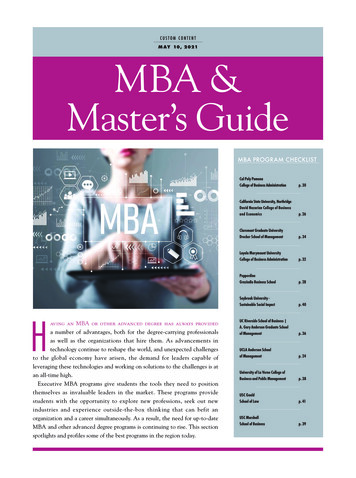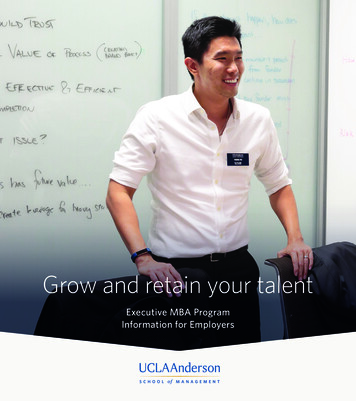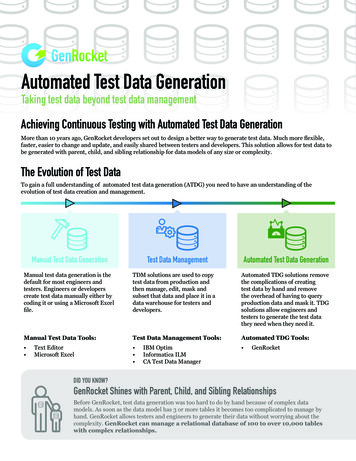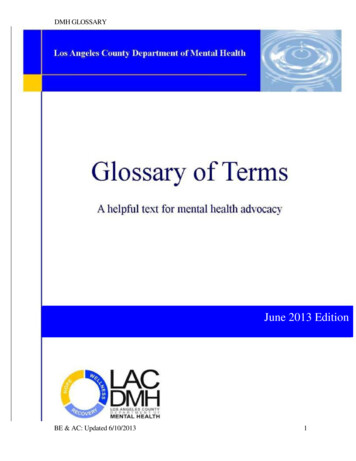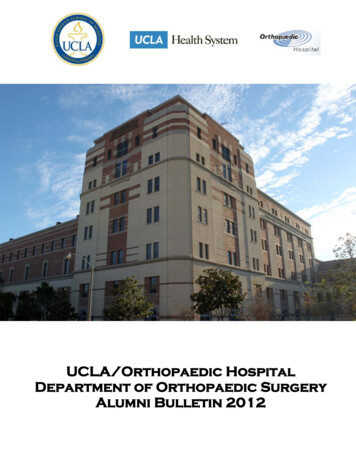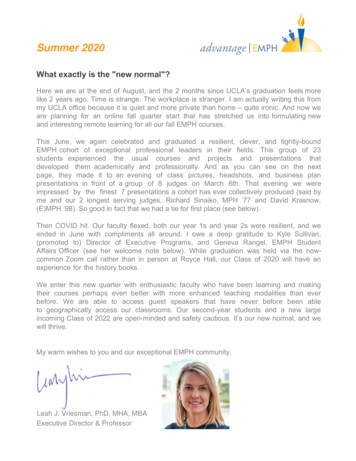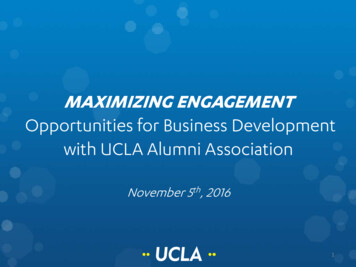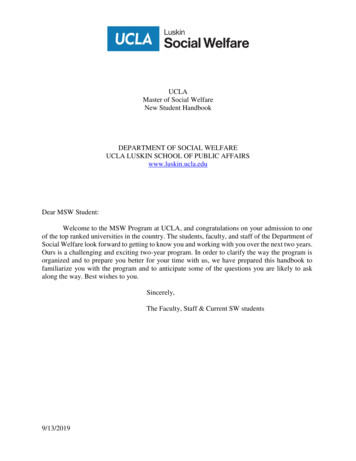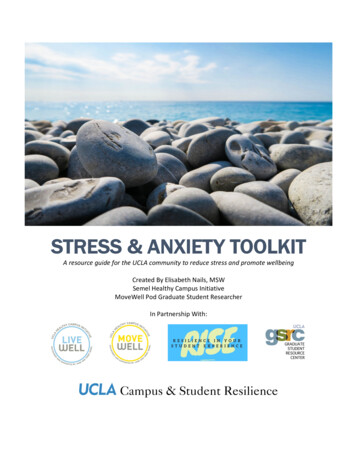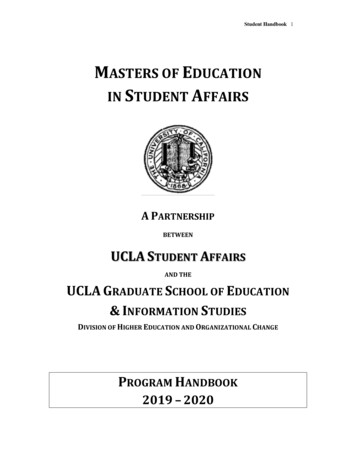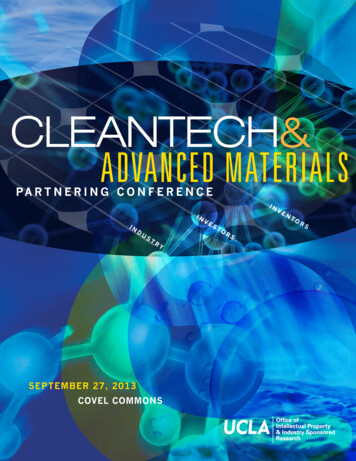
Transcription
I would like to welcome you to UCLA’s Cleantech & AdvancedMaterials Partnering Conference. UCLA is a leading center forinnovative research in the development of technologies that will havelasting impact on the world’s long-term needs. We are excited to haveyou join us for this opportunity to share, first-hand, the continuingefforts to address new challenges for our world as a whole.The scope and breadth of research at UCLA in this space isimpressive, due entirely to our enterprising faculty. The faculty whowill be presenting to you today are on the forefront of many importanttechnological developments, including transforming energy efficiency,facilitating the use of renewable resources, and ensuring that theworld has access to clean water.We hope you will appreciate their dedication and ingenuity in pushingscientific boundaries in impactful ways.In summary, we hope that this event will highlight the tremendouscalibre of research at UCLA, and provide a venue for you toconnect with our researchers and your peers. We aspire to makethis an ongoing event that will open new avenues for creativity andcommercialization.Sincerely,Brendan RauwAssociate Vice Chancellor andExecutive Director of Entrepreneurship 2013 UC Regents
Conference Program12:45 pmRegistration1:30 pmIra Ehrenpreis — General Partner, Technology PartnersWelcome/Keynote Address2:00 pmIndustry Panel — Representatives from Bayer MaterialScience, Boeing Spectrolab, Quallion,Schneider Electric, & Waste Management2:35 pmInvestor Panel — Representatives from Craton Equity Partners, US Renewables Group,& Venable LLP3:15 pmBruce Dunn — Materials Science and Engineering (Northridge Room)Topic: Three-Dimensional Battery ArchitecturesGaurav Sant — Civil & Environmental Engineering (West Coast Room)Topic: New Directions Toward Improving Carbon, Energy and DurabilityMetrics of Cementitious Materials and Concrete InfrastructureIvan Catton — Mechanical and Aerospace Engineering (South Bay Room)Topic: A Designer Fluid for Phase Change Heat Transfer DevicesRajit Gadh — Mechanical and Aerospace Engineering (Grand Ballroom “Salon A”)Topic: WINSmartEV — The UCLA Smart Electric Vehicle Charging NetworkOptimized for Customer, EV, Parking Facilities and Grid Usage3:45 pmQibing Pei — Materials Science and Engineering (Northridge Room)Topic: Transparent Polymer Composite Conductors: Opportunities forFlexible and Stretchable Thin Film Electronic DevicesEric Hoek — Civil & Environmental Engineering (West Coast Room)Topic: Innovations in Water Technology for Desalination, Oil & Gas Production andWaste-to-Energy ApplicationsLaurent Pilon — Mechanical and Aerospace Engineering (South Bay Room)Topic: Novel Thermal and/or Mechanical Energy Conversion Using Ferroelectric Materials4:15 pmLarry Carlson — Institute for Technology Advancement (Northridge Room)Topic: BruinPatch: UCLA and NIST Funding Unite to Create a New Approachto Fixing Our Streets and HighwaysYoram Cohen — Chemical & Biomolecular Engineering (West Coast Room)Topic: Surface-Nanostructuring with Polymers for Membranes andChemical SensorsRichard Wirz — Mechanical and Aerospace Engineering (South Bay Room)Topic: Green Energy: Solar Thermal, Wind, and Plasma Materials4:45 pmRichard Kaner — Materials Science and Engineering (Northridge Room)Topic: Graphene SupercapacitorsJames Liao — Chemical and Biomolecular Engineering (West Coast Room)Topic: Exploring Principles of Metabolic Engineering for Fuels andChemicals ProductionYu Huang — Materials Science and Engineering (South Bay Room)Topic: Engineering Highly Effectively Nanocatalysts for Fuel-cell Applicationsand Beyond5:15 pmReception on TerraceUCLA Cleantech & Advanced Materials Partnering Conference 1
ContentsSpeaker ProfilesUCLA Technologies Available for LicenseEnergy Technologies31011Solar11Alternative Fuels12Storage at Management15Water Technologies15Materials Technologies17Conference Sponsors25Contact Information262 UCLA Cleantech & Advanced Materials Partnering Conference
Larry E. CarlsonIvan Catton, Ph.D.Director of Advanced MaterialsUCLA Engineering Institute for Technology Advancement(ITA)Professor of EngineeringMechanical and Aerospace lcarlson@ita.ucla.eduLarry Carlson is Associate Director of the UCLAEngineering Institute for Technology Advancement, andDirector of Advanced Materials. He is also the FundManager for the Easton Foundation where he focuseson developing new materials for use in the aerospaceand sporting goods industries. He serves as PrincipleInvestigator (PI) and co-PI on several privately andgovernment funded programs, including research for theNational Institute of Standards and Technology (NIST)and the U.S. Department of Defense (DOD). His currentspecialty is carbon nanotube-based composites formultifunctional properties.Prior to joining UCLA in 2009, he spent 20 yearsat Easton Sports where he was Vice President forResearch and Development. Prior to that, he spent 15years with Alcoa in various engineering managementand marketing management roles. He received hisB.S. in Mechanical Engineering from Lehigh Universityand has done graduate work at Lehigh University, theUniversity of Pittsburgh, and attoncatton@ucla.eduIvan Catton is Professor in the Mechanical andAerospace Engineering Department at UCLA. Hereceived his Ph.D. in Engineering from UCLA in 1966.For over 40 years, Ivan Catton has made significantcontributions to a wide variety of basic and appliedproblems in thermal science and engineering, includingnatural convection, flow instability, solar energy utilization,porous media transport, and nuclear reactor safety.Recently he has developed a new, patent pending heattransfer fluid. Professor Catton has served as Directorof the Morin-Martinelli-Gier Memorial Heat TransferLaboratory since 1984. Catton is a Fellow of both ASMEand ANS, and has received an ASME Best Paper Award,the Heat Transfer Memorial Award and the Max JakobMemorial Award. He has also served as an associateeditor of the Journal of Heat Transfer. Professor Cattonhas published 430 research papers of which 190 are inthe archival literature.UCLA Cleantech & Advanced Materials Partnering Conference 3
Yoram Cohen, Ph.D.Bruce Dunn, Ph.D.ProfessorChemical & Biomolecular EngineeringDirector, UCLA Water Technology Research CenterNippon Sheet Glass Professor of Materials Scienceand er.ucla.eduprofyc@gmail.comDr. Cohen is a UCLA Professor of Chemical &Biomolecular Engineering (CBE) since 1981 andDirector of the UCLA Water Technology ResearchCenter. He is also on the faculty of the UCLA Instituteof the Environment and Sustainability and a UCLALuskin Scholar. He is a recognized expert in membraneseparation processes, surface nano-structuring, graftpolymerization, water purification and desalination,and environmental impact assessment, with over 200published research papers and book chapters in theabove areas. He developed patented technologiesfor smart water treatment and desalination systems,membrane monitoring, surface nano-structuredmembranes, in addition to software for nanoinformaticsand environmental impact assessment. Dr. Cohenand five Faculty co-founders of the UC Center forEnvironmental Impact of Nanotechnology received the2012 California Governor’s Award in Green Chemistry.He also is recipient of the AIChE Lawrence K. Cecilaward in Environmental Chemical Engineering (2003)and the Ann C. Rosenfield Community Partnership Prize(2008) in recognition of his environmental research,and State of California Senate and US CongressionalCertificates of Recognition (2008) for contributing tolegislation to protect public health.4 UCLA Cleantech & Advanced Materials Partnering n.htmlbdunn@ucla.eduBruce Dunn is the Nippon Sheet Glass Professor ofMaterials Science and Engineering at UCLA. He wasa staff scientist at the General Electric CorporateResearch and Development Center before joiningUCLA. His research interests concern the synthesisof inorganic materials and characterization of theirelectrical, optical, biological and electrochemicalproperties. His recent work on electrochemical energystorage includes research on three-dimensional batteriesand pseudocapacitor materials. He has authored orco-authored over 300 papers in scientific and technicaljournals and has been awarded 13 patents with severalothers pending. He has received a number of honorsand awards including a Fulbright research fellowship,invited professorships and two awards from DOE for hisresearch in materials science. He is a Fellow of both theAmerican Ceramic Society and the Materials ResearchSociety.
Rajit Gadh, Ph.D.Eric M.V. Hoek, Ph.D.ProfessorDirector, Smart Grid and Energy Research CenterProfessor & Industrial Affiliates Program DirectorCivil & Environmental EngineeringInstitute of the Environment & SustainabilityCalifornia NanoSystems cla.eduDr. Rajit Gadh is a Professor at the Henry SamueliSchool of Engineering and Applied Science atUCLA, Founder and Director the Smart Grid EnergyResearch Center or SMERC (http://smartgrid.ucla.edu) and Founder and Director of the UCLA WINMECConsortium (http://winmec.ucla.edu). Dr. Gadh hasa Doctorate degree from Carnegie Mellon University(CMU), a Masters from Cornell University and aBachelors degree from IIT Kanpur all in engineering.He has taught as a visiting researcher at UC Berkeley,has been an Assistant, Associate and Full Professorat University of Wisconsin-Madison, and was a visitingresearcher at Stanford la.eduEric M.V. Hoek is a Professor in the UCLA Departmentof Civil & Environmental Engineering. His UCLAresearch group explores the union of nanomaterials andmembrane technologies for water, energy, biomedicaland environmental applications. In the past decade, hehas co-authored over a hundred scientific articles, bookchapters, patents and proceedings papers, is a formerEditor of the journal Desalination and recently co-editedThe Encyclopedia of Membrane Science & Technologyfor John Wiley & Sons.Hoek also enjoys applying his basic research knowledgeto practical applications having consulted for a rangeof private companies, law firms, US federal, state andlocal agencies, private research foundations, NGOs andforeign national research agencies. Dr. Hoek has servedas an advisor on major water reuse and desalinationprojects in Southern California, and has been involvedwith the formation of several water technology startupcompanies including NanoH2O (nanoh2o.com) andWater Planet Engineering (wpeh2o.com).UCLA Cleantech & Advanced Materials Partnering Conference 5
Yu Huang, Ph.D.Richard B. Kaner, Ph.D.Associate ProfessorMaterials Science and EngineeringCalifornia NanoSystems InstituteDistinguished Professor of ChemistryDistinguished Professor of Materials Scienceand ulty/kanerkaner@chem.ucla.eduProfessor Huang is an Associate Professor in theDepartment of Materials Science and Engineeringat UCLA. She received her B.S. in Chemistry fromUniversity of Science and Technology of China and herPh.D. in Physical Chemistry from Harvard University.Before she joined UCLA, she was a LawrencePostdoctoral Fellow in Lawrence Livermore NationalLabs. At UCLA, Professor Huang and her groupexplore the unique technological opportunities thatresult from the structure and assembly of nanoscalebuilding blocks. Focusing on the molecular level, sheconducts research to unravel the fundamental principlesgoverning nanoscale material synthesis and assembly;and utilizes such principles to design nanostructuresand nanodevices with unique functions and properties toaddress critical challenges in electronics, energy scienceand biomedicine. Recognitions she received include theWorld’s Top 100 Young Innovators, the Sloan Fellowship,the PECASE, DARPA Young Faculty Award and the NIHNew Innovator Award.Richard B. Kaner received a Ph.D. in inorganic chemistryfrom the University of Pennsylvania in 1984 workingwith Prof. Alan MacDiarmid (Nobel Laureate 2000).After carrying out postdoctoral research at the Universityof California, Berkeley, he joined the University ofCalifornia, Los Angeles (UCLA) in 1987 as an AssistantProfessor. He was promoted to Associate Professorwith tenure in 1991, became a Full Professor in1993 and a Distinguished Professor in 2012. He haspublished over 275 papers in top peer reviewed journalsand holds 14 U.S. patents with 20 more pending.Professor Kaner has received awards from the Dreyfus,Fulbright, Guggenheim and Sloan Foundations as wellas the Exxon Fellowship in Solid State Chemistry, theBuck-Whitney Research Award, the Tolman Medaland the Award in the Chemistry of Materials from theAmerican Chemical Society for his work on refractorymaterials including new synthetic routes to ceramics,intercalation compounds, superhard metals, grapheneand conducting polymers. He has been elected a Fellowof both the American Association for the Advancementof Science (AAAS) and the Materials Research Society(MRS). Along with appointments in the Departmentsof Chemistry and Materials Science & Engineering,Professor Kaner served as the Associate Director ofthe California NanoSystems Institute from 2007-09.Professor Kaner’s teaching has been recognized withthe Hanson-Dow Award for Excellence in Teaching, theHarriet and Charles Luckman Distinguished TeachingAward and the Gold Shield Faculty Prize for AcademicExcellence.6 UCLA Cleantech & Advanced Materials Partnering Conference
James C. Liao, Ph.D.Qibing Pei, Ph.D.Ralph M. Parsons Foundation Professor and ChairChemical and Biomolecular EngineeringProfessorMaterials Science and Engineeringhttp://www.seas.ucla.edu/ ople/bios/peiqpei@seas.ucla.eduDr. James C. Liao, Ralph M. Parsons FoundationProfessor and Department Chair, Chemical andBiomolecular Engineering of UCLA, is a pioneer inMetabolic Engineering. He received his B.S. degree fromNational Taiwan University and Ph.D. from Universityof Wisconsin-Madison. After working as a researchscientist at Eastman Kodak Company, Rochester,NY, he started his academic career at Texas A&MUniversity in 1990 and moved to UCLA in 1997. Hereceived numerous awards, including Merck Award forMetabolic Engineering (2006), Food, Pharmaceutical,and Bioengineering Division award of American Instituteof Chemical Engineers (AIChE) (2006), CharlesThom Award of the Society for Industrial Microbiology(2008), Marvin Johnson Award of American ChemicalSociety (2009), Alpha Chi Sigma Award of AIChE(2009), James E. Bailey Award of Society for BiologicalEngineering (2009), Presidential Green ChemistryChallenge Award (2010), and the White House“Champion of Change” for innovations in renewableenergy (2012). In 2013, he was elected to the NationalAcademy of Engineering, and was named a co-winnerof the ENI Renewable Energy Prize, bestowed by thePresident of Italy.Qibing Pei is Professor of Materials Science andEngineering, UCLA. He specializes in synthetic polymersand composites for electronic, electromechanical, andphotonic applications, with over 120 peer-reviewedjournal publications. He is the inventor or co-inventorof 39 awarded US patents covering polymer OLEDs,dielectric elastomers with greater than 100% actuatedstrain, light emitting polymers, and related materialsand thin film devices. His current research activitiesinclude synthesis of conjugated polymers, stretchablepolymer electronics, nanostructured composites, polymeractuators and generators. Dr. Pei received a B.S. degreefrom Nanjing University, China, and a Ph.D. from theInstitute of Chemistry, Chinese Academy of Science,Beijing. He was a postdoctoral scientist in LinköpingUniversity, Sweden, a senior chemist 1994-1997 atUNIAX Corporation (now DuPont Display), SantaBarbara, and a senior research engineer 1998-2004 atSRI International, Menlo Park, California. He has been onthe UCLA faculty since 2004. He was named a Fellowof the SPIE in 2012.UCLA Cleantech & Advanced Materials Partnering Conference 7
Laurent Pilon, Ph.D.Gaurav N. Sant, Ph.D.ProfessorMechanical and Aerospace EngineeringAssistant Professor and Edward K. andLinda L. Rice Endowed Chair in Materials ScienceCivil and Environmental Engineeringhttp://www.seas.ucla.edu/ pilonpilon@seas.ucla.eduLaurent Pilon is Professor in the Mechanical andAerospace Engineering Department at UCLA. Hereceived his Ph.D. in Mechanical Engineering fromPurdue University in 2002. Professor Pilon’s laboratoryfocuses on synthesizing, characterizing, and modelingmaterials for waste heat energy harvesting and energystorage applications. In particular, his team has developedpatent-pending processes and devices to convert wasteheat and/or ambient mechanical energy directly intoelectricity. Professor Pilon is the recipient of the 2005National Science Foundation CAREER Award, the2008 Bergles-Rohsenow Young Investigator Awardin Heat Transfer from ASME, and the 2009 YoungScientist Award in Radiative Transfer from the Journal ofQuantitative Spectroscopy and Radiative Transfer. He waselected Senior Member of SPIE in 2011.8 UCLA Cleantech & Advanced Materials Partnering Conferencehttp://lcc-ucla.comgsant@ucla.eduGaurav Sant earned his BSCE (2006), MSCE (2007)and Ph.D. (2009) in civil engineering from PurdueUniversity and spent a post-doctoral year (2010) at theEcole Polytechnique Federale de Lausanne. Gaurav’sresearch is focused on the development of sustainablematerials for infrastructure construction, with specialemphasis on reducing the CO2 and energy use impactsof cement and cement-based derivatives in applicationsranging from bridges to buildings. This work whichis supported by federal, state and industrial partnersleverages both experimental and computational platformsto seek cutting-edge solutions to “material’s sustainabilityconcerns” facing the construction industry. The outcomesof this work have been published in over 45 papers ininternational journals and conference proceedings.
Richard Wirz, Ph.D.Assistant ProfessorDirector, UCLA Plasma & Space Propulsion LaboratoryDirector, UCLA Energy Innovation cla.eduRichard Wirz is an Assistant Professor in the Mechanicaland Aerospace Engineering Department at UCLA andholds a joint appointment in JPL’s Electric PropulsionGroup. He is the Director of the UCLA Plasma & SpacePropulsion Laboratory and the UCLA Energy InnovationLaboratory. His plasma and space related researchfocuses on advanced propulsion concepts and theplasma science relevant to these devices. His energyresearch currently focuses on new approaches to solarthermal energy storage and wind energy capture.UCLA Cleantech & Advanced Materials Partnering Conference 9
UCLA Technologies Available for LicenseEnergy TechnologiesSolarAlternative FuelsStorage SystemsSmartgridWindThermo/PyroelectricsHeat Managementpage 11page 12page 12page 14page 14page 14page 15Water Technologies by FacultyYoram Cohenpage 15Eric Hoekpage 16Advanced Materials Technologies by FacultyLarry Carlson – polymers nanopage 17Greg Carman – composites electronicspage 17Jane Chang – manufacturing electronics nanopage 17Chi On Chui – manufacturing electronics nanopage 17Xiangfeng Duan – manufacturing composites electronicspage 17Bruce Dunn – manufacturing electronicspage 17Mark Goorsky – manufacturing electronicspage 18George Grüner – manufacturing polymers composites electronics nanopage 18Vijay Gupta – polymerspage 18Hong Hahn – manufacturing polymerspage 18Diana Huffaker – composites manufacturing nanopage 18Jiann-Wen Ju – construction concrete asphaltpage 19Richard Kaner – polymers composites manufacturing electronics nanopage 19Prakash Koonath – manufacturingpage 20Ching Hwa Kwang – polymers electronics nanopage 20Daniel Leff – polymers nanopage 21Ken Nobe – manufacturing electronicspage 21Qibing Pei – polymers Energy solar manufacturing electronicspage 21Gaurav Sant – concretepage 21Sarah Tolbert – polymers Water membranes manufacturing electronicspage 22King-Ning Tu – manufacturing electronicspage 22Fred Wudl – manufacturing polymerspage 22Ya-Hong Xie – manufacturing electronicspage 23Jenn-Ming Yang – compositesYang Yang – electronics composites manufacturing polymerspage 23page 2310 UCLA Cleantech & Advanced Materials Partnering Conference
Energy TechnologiesSolarVertical Heterostructures forTransistors, Photodetectors,and Photovoltaic DevicesProfessor Duan and colleagueshave developed a vertical field-effecttransistor (VFET) that enables highcurrent density through the overallsemiconductor area with a high on-offcurrent ratio. Current densities reach2–5 orders of magnitude greater thanthose recently reported for verticaltunneling transistors or barristors.Integrating graphene with solutionprocessible semiconductor materialsto form vertically-stacked devices canlead to new types of low-cost, highperformance transistors, photodetectors,and solar cells.UCLA Case No. 2013-363Lead Inventor: Xiangfeng DuanPatent Status: PendingEnergy solar, Materials manufacturingHydrogen Production by aNovel Thermochemical WaterSplitting CycleProfessor Manousiouthakis andcolleagues have developed athermochemical cycle for decomposingwater into hydrogen and oxygen. Thereare many realizations of this processinvolving a variety of intermediates.Thermal decomposition of water usuallyrequires temperatures greater than2,000 C. This novel thermochemicalcycle can be operated at a relativelylow temperature of 900 C. Due toits lower operating temperatures, thedecomposition can be powered by avariety of energy sources, includingsolar energy. The innovation lies in theoptimization of intermediates, operatingtemperatures, kinetics, heat removaland control of the rate of reaction, andelectricity cogeneration.UCLA Case No. 2005-332Lead Inventor: Vasilios ManousiouthakisPatent Status: Issued – #7,960,063Energy solar thermo/pyroelectricsImproved PhotovoltaicEfficiency in SemiconductingPolymer/Fullerene Solar Cellsthrough Control of FullereneSelf-Assembly and StackingProfessor Tolbert and colleagues haveidentified a self-assembly method forarranging fullerene molecules thatresults in a 4X increase in solar cellenergy conversion efficiency (currentdensity; on average). This techniqueallows more control over the packingof individual molecules to provide forhigher material densities that result inimproved efficiency.UCLA Case No. 2008-662Lead Inventor: Sarah TolbertPatent Status: Pending – PublishedApplication #20090266416Energy solar, MaterialsCarbon Nanotube/NanowireThermo-Photovoltaic CellsProfessor Wang and colleagues havedeveloped three types of thermophotovoltaic (TPVs) cell structuresbased on a particular nanomaterial.The optical and electrical propertiesof these nanotechnology-based TPVscan be tuned during fabrication. Thismakes them suitable for applicationssuch as waste heat harvesting inindustrial manufacturing facilities,high performance-low radiationdevices for space applications, andother devices for next-generationelectrical conversion.UCLA Case No. 2005-603Lead Inventor: Kang WangPatent Status: Issued – #7,985,615Energy solar thermo/pyroelectrics,Materials manufacturingNanoparticle Hybrid Solar CellBased on a CopolymerSelf Assembly ProcessProfessor Wang and colleagueshave devised of a practical, low cost,large-scale production method formultilayered photovoltaic devicefabrication. Hybrid solar cells based onnanocrystals and nanoparticles requirehigh temperature and are expensiveto produce. In this technology, UCLAresearchers developed a copolymertemplate to form the nanoparticle array,which offers versatility in constructionand low cost compared to conventionalthermal annealing and chemicalsynthesis methods. The approachobviates the need for high temperature,which offers advantages for massproduction. The technology has wideapplications for portable devices,displays, modulators, detectors, LEDs,and power stations.UCLA Case No. 2011-206Lead Inventor: Kang WangPatent Status: Patent PendingEnergy solarA Stretchable Organic SolarCell Based on Semi-MetalGraphene/Polymer HybridUsing hybrid polymeric compositesand semi-metal graphene electrodes,UCLA researchers have developed astretchable solar cell that could be usedto conform to various uneven surfaces.The technology has broad applicationsto consumer goods — includingportable electronics and clothing – andinfrastructure development for bothurban and rural areas.UCLA Case No. 2010-670Lead Inventor: Kang WangPatent Status: Patent PendingEnergy solarPolarizing Photovoltaic Deviceand Its Application in LiquidCrystal Displays and TandemSolar CellsProfessor Yang and colleagueshave developed an energy recyclingtechnology called polarizing organicphotovoltaics, which can boost thefunction of the LCD by workingsimultaneously as a polarizer, aphotovoltaic device, and an ambientlight or sunlight photovoltaic panel.urning polarizers into energy-generatingphotovoltaic units recovers energy fromphotons which would be otherwise lost.Compared with their silicon or otherinorganic or organic-inorganic hybridcounterparts, a unique advantage ofthe organic conjugated materials isthat the molecular chains can be easilyreoriented.UCLA Case No. 2010-666Lead Inventor: Yang YangPatent Status: PendingEnergy solar thermo/pyroelectricsUCLA Cleantech & Advanced Materials Partnering Conference 11
Solution Synthesis andDeposition of Kesterite CopperZinc Tin Chalcogenide Filmsfrom Earth Abundant Elementsfor Solar Cell Applicationsbetween CZTS and CdS substitutes.To date, the research team hasdeveloped Cd-free photovoltaicdevices that have achieved conversionefficiencies over 3.5%.Professor Yang and colleagues havedeveloped a solution based methodfor Cu2ZnSnS4-precursor synthesis.Compared to currently-implementedmethods, this method is moreenvironmentally friendly, cheaper toexecute, and provides a powerful toolfor depositing uniform films in chemicalcompositions suitable for large scalesolar cell fabrication.UCLA Case No. 2013-584Lead Inventor: Yang YangPatent Status: PendingEnergy solarUCLA Case No. 2011-410Lead Inventor: Yang YangPatent Status: PendingEnergy solar, Materials manufacturingConjugated Low-BandgapPolymer for Electronic DevicesOrganic photovoltaic devices providean opportunity to utilize solar energyefficiently and at low cost. To harvesta greater spectrum of light, scientistshave sought to reduce the energybandgap of the active material. UCLAresearchers have developed a novellow-bandgap polymer that providesexcellent photovoltaic performance insingle junction devices (PCE 7%).This technology has application toorganic solar cells, tandem solar cells,transparent solar cells, field-effecttransistors, near infrared (NIR) organicphoto-detectors, and NIR organic lightemitting diodes, among others.UCLA Case No. 2013-071Lead Inventor: Yang YangPatent Status: PendingEnergy solar, MaterialsAn Approach to Deposit aCd-Free Buffer Layer forCZTS Solar CellsCu2ZnSnS4 (CZTS) absorber materialspoint the way to the next generation ofthin film solar cells for both ecologicallyand economically sustainablephotovoltaics. However, current n-typeemitters or buffer layers, containcadmium sulfide (CdS), a probablehuman carcinogen shown to be toxic.UCLA scientists have developed aCd-free buffer layer on CZTS, whichpreviously has been challenging due toa substantial conduction band offsetMultiple Donor/Acceptor BulkHeterojunction Solar CellsProfessor Yang and colleagues havedeveloped a new device structure fororganic photovoltaics that expandsthe absorption bandwidth andincreases overall device performanceof the organic solar cells. In contrastto multiple junction solar cells, theapproach does not require furtherfabrication steps, thereby mitigatingincreases in manufacturing costand complexity.UCLA Case No. 2013-919Lead Inventor: Yang YangPatent Status: PendingEnergy solarEnergy TechnologiesAlternative fuelsDieselzymes: DirectedEvolution of a More Stable andMethanol Tolerant Lipase forBiodiesel ProductionProfessor Bowie and colleagues havedeveloped a highly stable and methanoltolerant lipase. The engineered lipase(Dieselzyme 4) has 30-fold increasedstability over the wild type enzyme at50 C and 50-fold increased stabilityat high methanol concentrations.The improved methanol tolerance,thermostability, and longevity ofDieselzyme 4 make it easily the mostrobust lipase currently available forbiodiesel production. Unlike manyother lipases, Dieselzyme 4 is easilyexpressed in E. coli, allowing for simplelarge-scale production.UCLA Case No. 2013-299Lead Inventor: James BowiePatent Status: PendingEnergy alternative fuels12 UCLA Cleantech & Advanced Materials Partnering ConferenceA Controllable and RobustCell-Free System forFatty Acid ProductionProfessor Ho and colleagues havedeveloped a system that can producea large amount of fatty acids in shortperiods of time. The unique approachhas the advantage of not relying onexpression systems or living cells,thereby reducing expenses and theoverall complexity of the system. Theresearchers have documented thatthe production rate of fatty acids is anorder of magnitude higher than that oftraditional cell culture-based systems.Fatty acids have a great variety of use inthe health and cosmetic industries andare a well-characterized precursor tobiodiesel and other industrial chemicals.UCLA Case No. 2013-833Lead Inventor: Chih-Ming HoPatent Status: PendingEnergy alternative fuelsEnergy TechnologiesStorage SystemsHigh Capacity Silicide-AirPrimary BatteriesProfessor Duan and colleagueshave developed a novel group
and marketing management roles. He received his . (CMU), a Masters from Cornell University and a . Berkeley, he joined the University of California, Los Angeles (UCLA) in 1987 as an Assistant Professor. He was promot
